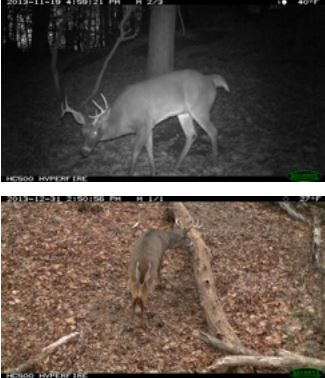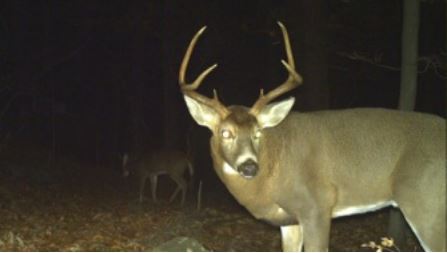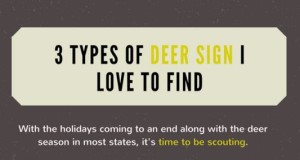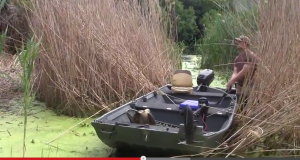Continuing from where we left off in part I, below are some additional tips to help you get the most
out of your scouting cameras this fall.
1) Protecting your camera from would be thieves. Last fall in CT I had 2 cameras stolen and both
were on private property. There’s nothing worse than walking up to where your camera SHOULD
be but it’s not. There’s a sinking feeling that overcomes you when you realize your camera was
stolen. On top of that, if another hunter becomes aware of the big buck you’ve been chasing, he’s
more likely to trespass, further disturb the area and hurt your chances of harvesting that animal.
One way to decrease the odds of theft is to place the camera well above the line of sight of other
people. This also markedly reduces the chances of deer spooking and you can get some really
cool images from high above.
To hang the camera I simply attach two Lone Wolf sticks to the tree,
climb up, hang the camera and angle it down towards the area I want to cover. Below are 2 pictures
of the same 8 pointer, one from ground level and one from 12’ up:

As a side note, if you look at the picture taken on 11/19/13 of this buck I call the “Thick 8”, you can see he
still had his rack fully intact. By 12/31/13 he had broken off the tip of his left main beam from fighting. On
12/31 the buck is checking out the remains of my mock scrape. Right above his head is where I hung a
tarsal gland from a buck I shot earlier in Nov. While he vigorously worked the licking branch above his
head he knocked it to the ground.
2) Hang cameras near where you expect to hunt. I know some hunters will say just the opposite
but I like to know when the activity heats up where I’ll actually be hunting so I can strike while the
iron’s hot. I don’t really care if a scrape is being worked under a lone oak tree in the middle of a
clover field because I can’t hunt it effectively. It also does me no good to know that the giant 5.5
year old bruiser is working the field edge at 2:00am when it’s impossible to hunt. What I want to
know is when that shooter is walking past my stand during daylight. I’d like to mention a quick story
about a buck I called “Newcomer”. I had several encounters with this deer but then for 3 weeks he
disappeared without a trace.
But by moving cameras around I was eventually able to get back on
him. I hung a Reconyx facing towards a doe bedding area then made a mock scrape the 2nd week
in November. A week later I pulled the card right before a light rain moved in and I left. When I
checked the card after my hunt I found him standing in the scrape while trailing a doe. I also had
multiple pictures of him working the scrape.
By placing your camera near the doe bedding areas
you’ll have a better chance of getting pictures of the local bucks. By using a quality camera you’ll
know that even after being outside for months you’ll have several pictures and excellent battery
power remaining. I hung this camera in early May and by the 3rd week of November, almost 7
MONTHS later it still had 90% battery power left! Many other brands would’ve missed the
opportunity at capturing this beautiful buck trailing the doe a mere 17 seconds later.

I’ve always opted for quality instead of quantity because cheaper equipment will eventually fail you and
with Murphy’s Law it’ll probably happen at the worst time, so why take the chance? I’d rather have 6
really good cameras than 12 unreliable cameras with dead batteries that must be replaced every 2-3
weeks. I’m convinced I’ve ruined great hunting spots because I had to replace batteries too often. By
constantly invading an area you leave scent and make noise no matter how careful you are. Although I
ended up having multiple encounters with “Newcomer” and came very close to wrapping my hands
around his rack on more than one occasion, I couldn’t close the deal.
As a matter of fact, it’s been years
since I’ve had that much fun deer hunting despite NOT harvesting the buck I was after. I learned A LOT
about his travel route, when the does come into heat in that area and how deer moved through the
property at different stages of the rut. Cameras can also prove/disprove your hunches about the
productivity of the area. There have been multiple times when I thought the conditions were perfect on
paper but the cameras told me a different story. Utilizing cameras to your advantage helps put the pieces
of the puzzle together in this chess game of deer hunting and makes it more fun in the process!
3) Use the weather to stay sneaky. I only like to check the cameras when the weather can hide both
my NOISE and my SCENT. If some of your cameras are placed on the edge of an open field you
can easily get in during the middle of the day, swap cards and get out without bothering the deer.
But if your camera is just downwind of a thick doe bedding area you’ll have to be extra careful.
Ideally you’ll want to pull the cards only after a hunt when you were going into the area anyway. In
all honesty I don’t like making separate trips just to check the cameras unless I can get in and out
seamlessly. If the area is sensitive to intrusion I’ll wait to check the camera until either the weather
can eliminate evidence of me being there or while I’m actually hunting. If for example you know it’s
going to rain around 6pm you should sneak in and swap cards between 5-6pm right before it starts.
Rain is obviously ideal but really windy weather also helps to remove evidence of your intrusion.
4) Don’t over check your cameras. Regardless of how excited you are to check that camera, how
scent-free or quiet you are with your approach, you’ll ALWAYS disturb the area, it’s just a reality.
Having said that, resist the temptation to check the cameras too often. In the summer I limit my
trips to once per MONTH. Remember with warm weather we sweat a lot more regardless of how
slow you walk or how careful you are with your scent control routine, so keep your trips to a
minimum.
During the hunting season I’ll check cameras about once every 1-2 weeks and I think
that’s adequate. With time you’ll learn how often you can check the cameras during hunting
season before if starts to affect the deer movement. Just remember to always take the same scent
control precautions while checking cameras as you would while hunting and you should be fine.
5) ALWAYS bring your bow while checking your cameras! I learned the hard way that the day you
leave your bow at home, is the day you’ll walk up on Mr. Big. It never hurts to carry your bow with
you whenever you’re in the woods. Two seasons ago I was walking towards my stand to check the
camera at 11:00am. 60 yards from my stand there was a small ridge that dropped off about 10’ and
as I slowly crested the ridge I came upon the largest 6 pointer I’ve ever laid eyes on. His chest was
so big it looked like you wrapped deer hide around a 55 gallon barrel! He was standing only a few
yards from a doe that was obviously in heat. I froze and S L O W L Y dropped to a knee, nocked an
arrow and came to full draw.
While at full draw the buck started to follow the doe who saw me and
ran off. I bleated to stop him and he did but not before sharply quartering away at 45 yards. I took
the shot and my arrow sailed over his back. I have to admit in that situation I was completely
caught off guard. I normally keep my cool before and during the shot but I missed judged the
distance and it cost me the buck. I was actually thinking about that deer while walking in and when
it happened it seemed surreal like it was a dream. I have a constant reminder of that encounter
every time I walk through that spot because my Muzzy broad head is still imbedded in the tree.
That encounter proved once again, that an opportunity can come along at any time so the hunter
must be ready. Anytime you’re in the woods during the season you should carry your bow even if
it’s “only” to check your camera. I ended up having another close encounter with that same buck 3
weeks later but I unfortunately I wasn’t able to harvest him. Here’s a mugshot of that giant 6 pointer:

I love utilizing cameras just as much as the next bowhunting fanatic but I also recognize they’re nothing
more than a tool. Having pictures of the buck you’re after keeps the hunt exciting. It lets you know he’s
still around and teaches you a lot about his habits
6) The beauty of scrapes. First of all, not all scrapes are equal. Most scrapes get visited at night but
some get a fair amount of daytime activity. Some scrapes are only boundary markers and will never be
worked more than once. Every now and again you’ll find a scrape that’s found in the perfect place. It’s a
scrape that’s just as likely to get worked at noon as it is at midnight. A primary scrape near thick security
cover that receives a lot of deer traffic is an example of a scrape worth hunting but you must be extra
careful. Scrapes are especially sensitive to human intrusion and can quickly go cold. Some scrapes only
get high traffic early in the season.
Last fall I acquired permission to hunt a new piece of property but I
wasn’t able to scout until mid-summer. While walking along the creek I found a scrape in mid-July.
Although the scrape was open it wasn’t worked recently. However, above the scrape were 4 overhanging
branches that were bent and heavily gnawed. The branches had deer hair imbedded in the ends and it
was obvious this was a primary scrape. Just down the ridge was a creek with cover so thick you couldn’t
crawl through it on your hands and knees if you wanted to. So I hung a camera over the scrape and
didn’t come back until the first week in August. When I checked the card there was a parade of bucks still
in their bachelor group walking single file down the trail.
All but one buck stopped to work the licking
branches above the scrape to leave a little scent. One buck really stood out like a sore thumb and I
called him “Shocker” because I was literally shocked to find a buck of that caliber on this property. This
buck was respectable for any state but especially for CT. I guessed it was a primary scrape back in July
and took a gamble by hanging the camera but the pictures confirmed my hunch. Below are a couple of
the bucks that showed up to say cheese:

I was excited to learn that by the 3rd week in August I had 2 really nice 4.5 yr. old bucks utilizing the
scrape on the same small property. Remember, a piece of property doesn’t have to be big in order to
hold mature bucks, it just has to be in the right location. Never get discouraged if you only have a small
place to hunt. If you properly hang cameras in the right locations you might be pleasantly surprised!
However, instead of taking advantage of what the camera showed me I played my hand wrong. Opening
day of the CT archery season in 2013 was Sept 16th and although I had to work that Monday, for almost
2 months I planned on sitting in my stand to overlook the scrape on Sept 17 for what would be my
opening day. After working almost 13 hours on the 16th I decided to sleep in Tuesday morning and
instead opted for an evening hunt on the 17th. After a fruitless hunt I pulled the card on my way out and I
saw that both the giant 7 pointer with a bent G2 on his left side I nicknamed “Bent 7” and the buck I called
“Shocker” showed up. “Bent 7” came in and worked the scrape on Sunday Sept 15th. Then on Tuesday
Sept 17th during legal shooting light, “Shocker” payed a visit to the scrape. Both bucks came from the
south around 6:45am. Because I slept in I was literally a day late and a dollar short. Man did I feel like a
lazy idiot for not forcing myself to get up. The worst part is that I knew better. I’ve never been more
frustrated because I planned what should have been a slam dunk hunt but instead I came home empty
handed.
MORAL OF THE STORY: Hunt the stand when both the camera and your gut tells you to!
“Bent 7”

“Shocker”

Here I am 4 days LATE to the party trying to make something happen AFTER the fact:

I personally learn by making mistakes and trust me when I say I’ve made the Lion’s share. I guess in the
end what motivates me to become a better hunter, doctor, husband and man in general is to keep
pushing myself and to learn from those mistakes. I love the idea of matching wits with a mature whitetail
and beating him at his own game before the season comes to an end. The good news is that if you can
learn from my fumbles at the 5 yard line it will spare you some frustration. Ultimately the one advantage
we have over the deer is our brain. If we add persistence, preparation and patience to that equation we’ll
end up with more successes in life than failures. It’s not easy to stay motivated because archery season
is definitely a marathon.
When it’s cold outside it’s difficult to get out of a warm bed only to sit for several
hours while 20’ up in a tree on a metal platform waiting for Mr. Big. And when you toss in extreme
conditions like snow, heavy wind and rain, it wears on even the most hardcore. But if you end the season
by punching a tag on that buck you’ve been after all year it’ll be worth it. I’d like to end with a quote from
a man that needs no introduction. It’s a good all around quote to help with keeping you motivated from a
person who’s had a ton of success because of his failures.
“I’ve missed more than 9,000 shots in my career. I’ve lost almost 300 games. 26 times, I’ve been trusted
to take the game winning shot and missed. I’ve failed over and over and over again in my life. And that is
why I succeed.” -Michael Jordan
 Public Land Hunters …get the deer hunting strategies you need
Public Land Hunters …get the deer hunting strategies you need




Thanks for such a great article. There are some REALLY good tips in these articles 🙂 Some people think that if you set up a camera you will find your target =, but dont realise that you still have to have a bit of tracking knowledge to help you find where to best put the trail camera. Time to get ready for the next open season 🙂